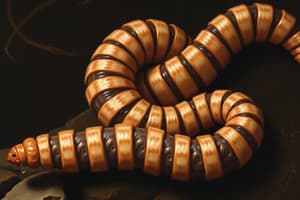Podcast
Questions and Answers
What is the defining characteristic of the phylum Annelida?
What is the defining characteristic of the phylum Annelida?
The defining characteristic of Annelida is that they have segmented bodies.
Describe the circulatory system of segmented worms.
Describe the circulatory system of segmented worms.
Annelids possess a closed circulatory system with blood vessels.
What is the role of setae in Annelida?
What is the role of setae in Annelida?
Setae help in locomotion by providing traction.
What type of reproductive system do most Annelids have?
What type of reproductive system do most Annelids have?
How do Annelids respire?
How do Annelids respire?
Name a class of Annelida and describe one of its characteristics.
Name a class of Annelida and describe one of its characteristics.
What is the ecological importance of oligochaetes like earthworms?
What is the ecological importance of oligochaetes like earthworms?
How do Annelids facilitate movement?
How do Annelids facilitate movement?
Flashcards
Annelida Segmentation
Annelida Segmentation
Annelids' bodies are divided into repeating segments.
Annelida Coelom
Annelida Coelom
A fluid-filled body cavity that gives annelids shape and support.
Annelida Hydrostatic Skeleton
Annelida Hydrostatic Skeleton
Annelids use internal fluid pressure to maintain body shape.
Annelida Closed Circulatory System
Annelida Closed Circulatory System
Signup and view all the flashcards
Polychaeta Annelids
Polychaeta Annelids
Signup and view all the flashcards
Oligochaeta Annelids
Oligochaeta Annelids
Signup and view all the flashcards
Hirudinea Annelids
Hirudinea Annelids
Signup and view all the flashcards
Annelida Reproduction
Annelida Reproduction
Signup and view all the flashcards
Study Notes
Phylum Annelida
-
Definition: Annelida, commonly known as segmented worms, is a phylum of invertebrates characterized by their segmented bodies.
-
Key Characteristics:
- Segmentation: Body divided into ring-like segments (metameres).
- Body Plan: Bilateral symmetry, triploblastic (three tissue layers).
- Coelom: True coelom (body cavity) filled with fluid.
- Skeletal System: Hydrostatic skeleton; maintains body shape through fluid pressure.
- Circulatory System: Closed circulatory system with blood vessels.
- Nervous System: Central nervous system with a ventral nerve cord and segmental ganglia.
- Reproductive System: Mostly hermaphroditic; some have separate sexes.
-
Respiration:
- Gas exchange occurs through the skin or specialized structures (gills in some aquatic species).
-
Locomotion:
- Movement facilitated by longitudinal and circular muscles; setae (bristles) aid in traction.
-
Feeding:
- Diverse feeding strategies: detritivores, predators, and filter feeders.
- Some have specialized mouthparts for digging or grasping.
-
Classes of Annelida:
- Polychaeta: Mostly marine; characterized by parapodia (side appendages) and numerous setae.
- Oligochaeta: Includes earthworms; primarily terrestrial; fewer setae and lack parapodia.
- Hirudinea: Leeches; mostly freshwater; lack setae and have a flattened body; some are blood-sucking parasites.
-
Ecological Role:
- Important in soil aeration and nutrient cycling (oligochaetes).
- Serve as a food source for various predators.
-
Economic Importance:
- Earthworms enhance soil fertility.
- Leeches used in medicinal applications (e.g., bloodletting, microvascular surgery).
-
Examples:
- Common earthworm (Lumbricus terrestris), Marine bristleworms (Polychaetes), Medicinal leech (Hirudo medicinalis).
-
Reproductive Strategies:
- Sexual reproduction through copulation; some can reproduce asexually through fragmentation.
-
Adaptations:
- Adaptations to various environments (marine, freshwater, terrestrial) with specialized structures for survival.
This overview encapsulates the fundamental aspects of Phylum Annelida, highlighting their biology, classification, and ecological significance.
Overview of Phylum Annelida
- Commonly known as segmented worms, characterized by segmented body structures.
Key Characteristics
- Segmentation: Body divided into distinct ring-like segments, known as metameres.
- Body Plan: Exhibits bilateral symmetry and is triploblastic with three layers of tissue.
- Coelom: Possesses a true coelom, which is a fluid-filled body cavity.
- Skeletal System: Utilizes a hydrostatic skeleton, allowing maintenance of body shape through internal fluid pressure.
Physiological Systems
- Circulatory System: Features a closed circulatory system, which includes blood vessels for efficient blood transport.
- Nervous System: Comprises a central nervous system with a ventral nerve cord and segmental ganglia for coordination.
- Reproductive System: Generally hermaphroditic; some species display separate sexes.
Respiration and Locomotion
- Respiration: Gas exchange provided through skin or specialized structures, such as gills in some marine species.
- Locomotion: Movement facilitated by longitudinal and circular muscles, with setae (bristles) enhancing traction on various surfaces.
Feeding Habits
- Diverse Diet: Includes detritivores, predators, and filter feeders, with some having specialized mouthparts for digging or grasping prey.
Classes of Annelida
- Polychaeta: Primarily marine worms, recognized by parapodia (side appendages) and numerous setae.
- Oligochaeta: Includes earthworms, mostly found on land, characterized by fewer setae and absence of parapodia.
- Hirudinea: Comprises leeches, mostly found in freshwater; the absence of setae and flattened bodies enable parasitic feeding for some species.
Ecological Roles
- Soil Aeration: Oligochaetes play a significant role in aerating soil and promoting nutrient cycling within ecosystems.
- Food Source: Serve as prey for various terrestrial and aquatic predators.
Economic Importance
- Soil Fertility: Earthworms contribute to enhanced soil fertility through organic matter processing.
- Medicinal Uses: Leeches are utilized in medical applications such as bloodletting and microvascular surgery.
Examples
- Lumbricus terrestris: Common earthworm known for improving soil conditions.
- Marine Bristleworms: Representing the Polychaeta class in marine environments.
- Hirudo medicinalis: The medicinal leech, highlighted for its therapeutic uses.
Reproductive Strategies
- Sexual Reproduction: Involves copulation between individuals; some species can also reproduce asexually via fragmentation.
Adaptations
- Environmental Specialization: Various adaptations exist to thrive in marine, freshwater, and terrestrial habitats, each with specialized structures for survival.
Studying That Suits You
Use AI to generate personalized quizzes and flashcards to suit your learning preferences.




